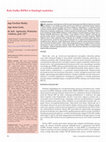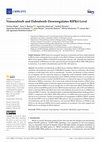Papers by Agnieszka Wolnicka-Glubisz

Journal of cancer research and clinical oncology, Apr 24, 2024
Purpose The receptor-interacting protein kinase (RIPK4) has an oncogenic function in melanoma, re... more Purpose The receptor-interacting protein kinase (RIPK4) has an oncogenic function in melanoma, regulates NF-κB and Wnt/β-catenin pathways, and is sensitive to the BRAF inhibitors: vemurafenib and dabrafenib which lead to its decreased level. As its role in melanoma remains not fully understood, we examined the effects of its downregulation on the transcriptomic profile of melanoma. Methods Applying RNA-seq, we revealed global alterations in the transcriptome of WM266.4 cells with RIPK4 silencing. Functional partners of RIPK4 were evaluated using STRING and GeneMANIA databases. Cells with transient knockdown (via siRNA) and stable knockout (via CRISPR/Cas9) of RIPK4 were stimulated with TNF-α. The expression levels of selected proteins were assessed using Western blot, ELISA, and qPCR. Results Global analysis of gene expression changes indicates a complex role for RIPK4 in regulating adhesion, migration, proliferation, and inflammatory processes in melanoma cells. Our study highlights potential functional partners of RIPK4 such as BIRC3, TNF-α receptors, and MAP2K6. Data from RIPK4 knockout cells suggest a putative role for RIPK4 in modulating TNF-α-induced production of IL-8 and IL-6 through two distinct signaling pathways-BIRC3/NF-κB and p38/MAPK. Furthermore, increased serum TNF-α levels and the correlation of RIPK4 with NF-κB were revealed in melanoma patients. Conclusion These data reveal a complex role for RIPK4 in regulating the immune signaling network in melanoma cells and suggest that this kinase may represent an alternative target for melanoma-targeted adjuvant therapy. Transcriptome • p-38 Abbreviations BRAFi BRAF inhibitors CRISPR/Cas9 Clustered regularly interspaced short palindromic repeats/CRISPR-associated protein 9 DEG Differentially expressed genes IL Interleukin RIPK4 Receptor-interacting serine/threonine kinase 4 TNF-α Tumor necrosis factor-alfa RNA-seq RNA-sequencing * Agnieszka Wolnicka-Glubisz

International Journal of Molecular Sciences
Melatonin (N-acetyl-5-methoxytryptamine, MEL), its kynurenic (N1-acetyl-N2-formyl-5-methoxykynure... more Melatonin (N-acetyl-5-methoxytryptamine, MEL), its kynurenic (N1-acetyl-N2-formyl-5-methoxykynurenine, AFMK) and indolic derivatives (6-hydroxymelatonin, 6(OH)MEL and 5-methoxytryptamine, 5-MT) are endogenously produced in human epidermis. Melatonin, produced by the pineal gland, brain and peripheral organs, displays a diversity of physiological functions including anti-inflammatory, immunomodulatory, and anti-tumor capacities. Herein, we assessed their regulatory effect on melanogenesis using amelanotic (A375, Sk-Mel-28) and highly pigmented (MNT-1, melanotic) human melanoma cell lines. We discovered that subjected compounds decrease the downstream pathway of melanin synthesis by causing a significant drop of cyclic adenosine monophosphate (cAMP) level, the microphthalmia-associated transcription factor (MITF) and resultant collapse of tyrosinase (TYR) activity, and melanin content comparatively to N-phenylthiourea (PTU, a positive control). We observed a reduction in pigment in me...

Postepy biochemii, Feb 23, 2021
Wykaz skrótów: BPS (ang. Bartsocas-Papas Syndrome) -zespół Bartsocas-Papas; CHAND (ang. Curly Hai... more Wykaz skrótów: BPS (ang. Bartsocas-Papas Syndrome) -zespół Bartsocas-Papas; CHAND (ang. Curly Hair-Ankyloblepharon-Nail Dysplasia) -zespół kręte włosy -zrośniete powieki-dysplastyczne paznokcie; IKK (ang. IκB kinase) -kinaza IκB; IL17 (ang. Interleukin 17) -Interleukina 17; IRF6 (ang. Interferon Regulatory Factor 6) -czynnik regulujący interferon 6; IκB (ang. Inhibitor of nuclear factor kappa B) -inhibitor czynnika jądrowego kappa B; JNK (ang. c-Jun N-terminal Kinase) -kinaza białka c-Jun; NF-κB (ang. Nuclear Factor kappa B) -jądrowy czynnik transkrypcyjny kappa B; NLS (ang. Nuclear Localization Signal) -sygnał lokalizacji jądrowej; PKC (ang. Protein Kinase C) -kinaza białkowa C; PKC-1β (ang. Protein Kinase C-like 1β) -kinaza białkowa C-1β; PKK (ang. Protein Kinase C-associated Kinase) -kinaza związana z PKC; PKP1 (ang. Plakophilin 1) -plakofilina 1; PMA (ang. Phorbol 12-Myristate 13 Acetate) -ester forbolu; PPS (ang. Popliteal Pterygium Syndrome) -zespół mnogich płetwistości typu Aslana; RIPK (ang. Receptor Interacting Protein Kinases) -oddziałujące z receptorem kinazy serynowo-treoninowo-białkowe; SCC (ang. Squamous Cell Carcinoma) -rak kolczystokomórkowy; STAT (ang. Signal Transducer and Activator of Transcription) -białka przekazujące sygnał i aktywujące transkrypcję; TLR (ang. Toll-like Receptors) -receptory Toll-podobne; TNFR-1 (ang. Tumor Necrosis Factor Receptor 1) -receptor czynnika martwicy nowotworów 1; TNFα (ang. Tumor Necrosis Factor α) -czynnik martwicy mowotworów α; TRAF (ang. TNF Receptor Associated Factor) -czynnik aktywujący zależny od TNF

Photochemistry and Photobiology, May 1, 2023
An acetylated riboflavin derivative, 3‐methyl‐tetraacetyl riboflavin (3MeTARF), is a compound wit... more An acetylated riboflavin derivative, 3‐methyl‐tetraacetyl riboflavin (3MeTARF), is a compound with high photostability and photophysical properties similar to riboflavin, including the ability to photogenerate singlet oxygen. In the present study, we compared the effects of irradiation on A431 cancer cells with blue LED light (438 nm) in the presence of 3MeTARF and riboflavin on MAPK phosphorylation, apoptosis, caspase 3/7 activation and PARP cleavage. We observed that photogenerated oxidative stress in this reaction activates MAPK by increasing phosphorylation of p38 and JNK proteins. Preincubation of cells with inhibitors specific for phosphorylation of p38 and JNK proteins (SB203580, SP600125), respectively, results in decreased caspase 3/7 activation and PARP cleavage. We showed that the tetraacetyl derivative more effectively activates MAPK and skin cancer cell death compared to riboflavin. These data, together with results of our previous study, support the hypothesis that 3MeTARF, of riboflavin, might be more useful and desirable as a compound for use in photodynamic oxidation processes, including its therapeutic potential.

Biophysical Chemistry, Sep 1, 2004
In this study, the effects of chlorpromazine (CPZ) on lipid order and motion in saturated (DMPC, ... more In this study, the effects of chlorpromazine (CPZ) on lipid order and motion in saturated (DMPC, DMPG) and unsaturated (SOPC) liposome membranes were investigated by electron spin resonance (ESR) spin labeling technique. We have shown that above the main phase transition temperature of membrane lipids (T(M)), CPZ slightly increases lipid order in membranes without cholesterol, whereas below T(M) it has a strong opposite effect. Addition of 30 mol% of cholesterol into DMPC and SOPC membranes changes significantly the CPZ effects both above and below T(M). Additionally, above T(M), the ordering effect of CPZ on pure SOPC membrane is stronger at pH 7.4 than at pH 9.0, whereas below T(M), as well as in the presence of cholesterol, pH does not seem to play a role in CPZ effect on both membranes. Because of the strong influence of membrane composition on CPZ effect on membranes, the use of cholesterol as a marker of CPZ photosensitized reactions has been discussed.

Cancers, Feb 1, 2023
Vemurafenib and dabrafenib are BRAF kinase inhibitors (BRAFi) used for the treatment of patients ... more Vemurafenib and dabrafenib are BRAF kinase inhibitors (BRAFi) used for the treatment of patients with melanoma carrying the V600E BRAF mutation. However, melanoma cells develop resistance to both drugs when used as monotherapy. Therefore, mechanisms of drug resistance are investigated, and new molecular targets are sought that could completely inhibit melanoma progression. Since receptor-interacting protein kinase (RIPK4) probably functions as an oncogene in melanoma and its structure is similar to the BRAF protein, we analyzed the impact of vemurafenib and dabrafenib on RIPK4 in melanomas. The in silico study confirmed the high similarity of BRAF kinase domains to the RIPK4 protein at both the sequence and structural levels and suggests that BRAFi could directly bind to RIPK4 even more strongly than to ATP. Furthermore, BRAFi inhibited ERK1/2 activity and lowered RIPK4 protein levels in BRAF-mutated melanoma cells (A375 and WM266.4), while in wild-type BRAF cells (BLM and LoVo), both inhibitors decreased the level of RIPK4 and enhanced ERK1/2 activity. The phosphorylation of phosphatidylethanolamine binding protein 1 (PEBP1)-a suppressor of the BRAF/MEK/ERK pathway-via RIPK4 observed in pancreatic cancer did not occur in melanoma. Neither downregulation nor upregulation of RIPK4 in BRAF-mutated cells affected PEBP1 levels or the BRAF/MEK/ERK pathway. The downregulation of RIPK4 inhibited cell proliferation and the FAK/AKT pathway, and increased BRAFi efficiency in WM266.4 cells. However, the silencing of RIPK4 did not induce apoptosis or necroptosis. Our study suggests that RIPK4 may be an off-target for BRAF inhibitors.
Contemporary Oncology/Współczesna Onkologia, Dec 12, 2007

Cancers, Oct 24, 2018
The protein p53 protects the organism against carcinogenic events by the induction of cell cycle ... more The protein p53 protects the organism against carcinogenic events by the induction of cell cycle arrest and DNA repair program upon DNA damage. Virtually all cancers inactivate p53 either by mutations/deletions of the TP53 gene or by boosting negative regulation of p53 activity. The overexpression of MDM2 protein is one of the most common mechanisms utilized by p53 wt cancers to keep p53 inactive. Inhibition of MDM2 action by its antagonists has proved its anticancer potential in vitro and is now tested in clinical trials. However, the prolonged treatment of p53 wt cells with MDM2 antagonists leads to the development of secondary resistance, as shown first for Nutlin-3a, and later for three other small molecules. In the present study, we show that secondary resistance occurs also after treatment of p53 wt cells with idasanutlin (RG7388, RO5503781), which is the only MDM2 antagonist that has passed phase II and entered phase III clinical trials, so far. Idasanutlin strongly activates p53, as evidenced by the induction of p21 expression and potent cell cycle arrest in all the three cell lines tested, i.e., MCF-7, U-2 OS, and SJSA-1. Notably, apoptosis was induced only in SJSA-1 cells, while MCF-7 and U-2 OS cells were able to restore the proliferation upon the removal of idasanutlin. Moreover, idasanutlin-treated U-2 OS cells could be cultured for long time periods in the presence of the drug. This prolonged treatment led to the generation of p53-mutated resistant cell populations. This resistance was generated de novo, as evidenced by the utilization of monoclonal U-2 OS subpopulations. Thus, although idasanutlin presents much improved activities compared to its precursor, it displays the similar weaknesses, which are limited elimination of cancer cells and the generation of p53-mutated drug-resistant subpopulations.
Journal of carcinogenesis & mutagenesis, 2014
The role of UV and pigmentation are very difficult to control for in human studies, and mechanism... more The role of UV and pigmentation are very difficult to control for in human studies, and mechanisms difficult to infer based on statistical association with melanoma. The animal models are not representative of the human situation. But on the other hand, animal studies can be useful for basic studies that will ultimately help in building up a picture of the overall network of in vivo cellular behavior and intra and inter cellular pathways contributing to melanoma progression and the effects (or not) of UV radiation in individuals with MC1R variants. This review describes that, although the Mc1r is a determinant of coat color phenotype as the MC1R is a determinant of hair and skin color in humans, deficiency of the Mc1r in mice is associated with a paradoxical lower incidence of melanoma.

Metabolites
Melatonin (N-acetyl-5-methoxytryptamine) is recognized as an effective antioxidant produced by th... more Melatonin (N-acetyl-5-methoxytryptamine) is recognized as an effective antioxidant produced by the pineal gland, brain and peripheral organs, which also has anti-inflammatory, immunomodulatory, and anti-tumour capacities. Melatonin has been reported as a substance that counteracts ultraviolet radiation B (UVB)-induced intracellular disturbances. Nevertheless, the mechanistic actions of related molecules including its kynurenic derivatives (N1-acetyl-N2-formyl-5-methoxykynurenine (AFMK)), its indolic derivatives (6-hydroxymelatonin (6(OH)MEL) and 5-methoxytryptamine (5-MT)) and its precursor N-acetylserotonin (NAS) are only poorly understood. Herein, we treated human epidermal keratinocytes with UVB and assessed the protective effect of the studied substances in terms of the maintenance of mitochondrial function or their radical scavenging capacity. Our results show that UVB caused the significant elevation of catalase (CAT) and superoxide dismutase (Mn-SOD), the dissipation of mitoc...

Photochemistry and Photobiology, Jul 4, 2022
Curcumin is a plant‐derived yellow‐orange compound widely used as a spice, dye and food additive.... more Curcumin is a plant‐derived yellow‐orange compound widely used as a spice, dye and food additive. It is also believed to have therapeutic effects against different disorders. On the other hand, there are data showing its phototoxicity against bacteria, fungi and various mammalian cells. Since the mechanism of its phototoxic action is not fully understood, we investigated here the phototoxic potential of curcumin in liposomal model membranes and in HaCaT cells. First, detection of singlet oxygen (1O2) luminescence proved that curcumin generates 1O2 upon blue light irradiation in organic solvent and in liposomes. Then, HPLC‐EC(Hg) measurements revealed that liposomal and cellular cholesterol is oxidized by 1O2 photogenerated by curcumin. Enrichment of liposome membranes with curcumin significantly increased the oxygen photo‐consumption rate compared to the control liposomes as determined by EPR oximetry. Cytotoxicity measurements, mitochondrial membrane potential analyses and protein hydroperoxides detection confirmed strong phototoxic effects of curcumin in irradiated HaCaT cells. These data show that since curcumin is advertised as a valuable dietary supplement, or a component of cosmetics for topical use, caution should be recommended especially when skin is exposed to light.

Antioxidants
Curcumin, a natural polyphenol widely used as a spice, colorant and food additive, has been shown... more Curcumin, a natural polyphenol widely used as a spice, colorant and food additive, has been shown to have therapeutic effects against different disorders, mostly due to its anti-oxidant properties. Curcumin also reduces the efficiency of melanin synthesis and affects cell membranes. However, curcumin can act as a pro-oxidant when blue light is applied, since upon illumination it can generate singlet oxygen. Our review aims to describe this dual role of curcumin from a biophysical perspective, bearing in mind its concentration, bioavailability-enhancing modifications and membrane interactions, as well as environmental conditions such as light. In low concentrations and without irradiation, curcumin shows positive effects and can be recommended as a beneficial food supplement. On the other hand, when used in excess or irradiated, curcumin can be toxic. Therefore, numerous attempts have been undertaken to test curcumin as a potential photosensitizer in photodynamic therapy (PDT). At th...
Journal of Investigative Dermatology, 2004
Photochemistry and Photobiology

Cancers
Vemurafenib and dabrafenib are BRAF kinase inhibitors (BRAFi) used for the treatment of patients ... more Vemurafenib and dabrafenib are BRAF kinase inhibitors (BRAFi) used for the treatment of patients with melanoma carrying the V600E BRAF mutation. However, melanoma cells develop resistance to both drugs when used as monotherapy. Therefore, mechanisms of drug resistance are investigated, and new molecular targets are sought that could completely inhibit melanoma progression. Since receptor-interacting protein kinase (RIPK4) probably functions as an oncogene in melanoma and its structure is similar to the BRAF protein, we analyzed the impact of vemurafenib and dabrafenib on RIPK4 in melanomas. The in silico study confirmed the high similarity of BRAF kinase domains to the RIPK4 protein at both the sequence and structural levels and suggests that BRAFi could directly bind to RIPK4 even more strongly than to ATP. Furthermore, BRAFi inhibited ERK1/2 activity and lowered RIPK4 protein levels in BRAF-mutated melanoma cells (A375 and WM266.4), while in wild-type BRAF cells (BLM and LoVo), bo...
Photochemistry and Photobiology
susceptibility to UV induced cutaneous malignant melanoma in a mouse model









Uploads
Papers by Agnieszka Wolnicka-Glubisz